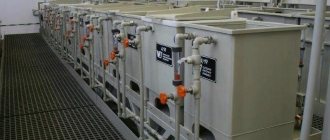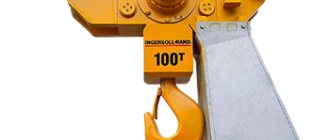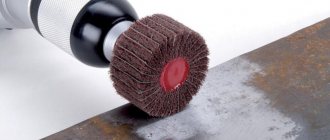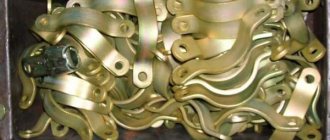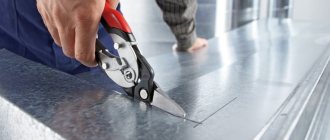Shabrovka - what is it, what equipment is it performed with?
The word comes from the German schaben, that is, to scrape. The operation is carried out by a mechanic and requires high precision. As a rule, it is a finishing treatment, but can also be used to fit two elements. To make the contact as tight as possible, special paint is applied to the ends, which is cut off to form a mesh. It provides an excellent connection. Also, the coloring agent is intended to fill voids. Irregularities are identified, then convex moments are removed. What is metal scraping - this is the final metalworking operation for the surfaces of parts, when thin chips are removed with a tool. It has a comfortable handle and rod. The blade itself is equipped with three or four working edges, which give different results. The job of a locksmith is to remove metal particles.
Purpose
It is used for finishing metalworking, when objects interact with minimal friction, perfectly complementing each other. The operation allows you to achieve maximum smoothness even with miniature workpiece sizes. Typically this step is required during production:
- measuring and control instruments, as they must have high accuracy;
- sliding bearings - in the presence of irregularities, friction will appear, deforming the shaft, as well as the risk of rapid wear and misalignment of the axle;
- guides of any machines;
- car engines and some other car spare parts.
This list may also include all components for which accuracy and the absence of any defects are important.
Main advantages
The main advantage of scraping is the high wear resistance of the treated surface. The absence of abrasive particles has a positive effect on the integrity of the metal structure. The treated surface has a low coefficient of friction, which increases the service life of lubricants.
The quality of scraping can be determined without the use of expensive instrumentation. The indicator in this case will be ordinary paint, the number of spots of which can indicate the degree of treatment of the surface.
What is metal surface scraping, where and why is it done?
Among all processing procedures, scraping is used in 25% of cases. Its main advantage over grinding with abrasives is the preservation of greater wear resistance and extended service life. Also, such a top layer is the most prepared for preserving lubricant, since shallower fragments alternate with depressions. The degree of roughness is achieved in two stages:
- preparatory – cut to 0.03 mm;
- final – up to 0.08 mm.
The technology is used in mechanical engineering of any complexity, as well as in the manufacture of spare parts and assemblies. It is carried out in factories, and only part of the work can be performed automatically (large planes), the rest is performed manually by a scraper.
Types of scrapers by design and shape of the cutting edge
Initially, there are two types according to their intended purpose - a construction one, which can be used to work on various soft materials, and a metal one. It is made of durable steel and is designed for metal working. Structurally, it differs in a number of elements.
Surface for different types and principles
The cutting part of the knife can be:
- With several edges - penetrates well into cracks, corners, and the inner sides of cylindrical objects. There is a straight or curved tip.
- Special configuration for a specific task - they need to be used wisely when stream processing is in progress. It is often collapsible - several different tips can be installed in the handle.
- Flat – optimally suits flat surfaces. The blade can have one side or two, the second option is more durable. Length - 25-40 cm. Width from 5 mm to 3 cm - the narrower the edge, the more accurate the thin scraping.
Handle and working part of the scraper
Different purposes require different sharpening. In order not to get confused in the mass of products and not to sharpen them every time in a new way, you can use replaceable plates. Such a universal weapon has several components:
- handle;
- metal case;
- clamp holder with screw;
- set of inserts.
The working part is fastened by turning the handle.
Degrees of automation
There is also an electric option. But a scraper is a mechanic who works a lot with his hands, because an electric scraper can only process straight surfaces or carry out primary processing, while finishing remains with ordinary equipment. The automated construction device is multifunctional; it removes residues of glue, putty, and other building materials, but is absolutely not suitable for metal.
Scraping stages
Metal scraping requires dexterity and practical skills that a beginner may lack. Therefore, it is better to entrust this operation to an experienced locksmith. It is recommended to perform scraping of products on a wood slab, and the procedure itself looks like this:
- Before cleaning, prepare or buy in the store a paint mixture based on soot and motor oil. The mixture must be thick and sticky so that it can adhere to the surface of the part being treated. Apply the mixture using a swab to the entire surface of the wood slab and let it dry for 1-2 minutes. The mixture should be applied evenly over the entire area of the slab in 1 layer (otherwise the accuracy of control measures will be significantly reduced).
- Now take the part that will be processed, and then attach it to the blockboard coated with paint. After a couple of minutes, remove it from the stove and look at the color spots that formed after applying the part. White dry spots indicate that the part has a large depression or crack at the application site (scraping is useless and even harmful for them). Black spots indicate that the surface is uniform and does not contain depressions. Gray color indicates the presence of small protrusions - these are the ones that require scraping.
- Sharpen the tool and begin removing rough edges using a scraper. During work, it is recommended to make movements “from yourself”, and the scraper itself should be held at an angle of 30-45 degrees relative to the plane of the object. Forward movements must be made with firm pressure to cut off excess metal. By controlling the degree of pressure, you can control the cutting depth. The tool should be returned back calmly, without pressure. The optimal tool stroke is 2-3 centimeters, and as the metal surface is leveled, the stroke should be reduced to 0.5-1 centimeters.
- Using a clean rag, remove any metal debris that may have formed during processing from the surface of the part being treated. Also be sure to dry the wood board and apply a new coat of paint. Now again attach the workpiece to the surface of the table with the applied paint. After a few minutes, remove the part and pay attention to the color of the stains. If there are gray spots left on the table, the scraping operation should be repeated. If the part is small, then you don’t have to apply paint - instead, you can use an unused area of the slab (this reduces work time and reduces paint costs).
Preparing for scraping
The use of scraping is determined by the task of obtaining a highly precise surface in terms of smoothness. Therefore, the use of specialized tools to achieve such a result when working with materials with a rough surface is not justified.
Accordingly, the workpieces initially go through the stages of primary cleaning, as well as grinding and even polishing. The demand for the latter operations is determined by the parameters with which specific plumbing work and, in particular, scraping are carried out.
Experienced craftsmen practice using calibration parts. These are blanks that are exemplary for the resulting product. Also at this stage, auxiliary equipment should be ready, with the help of which the operator will carry out individual technological actions.
For example, a special priming oil or paint may be used.
Lapping and scraping - what's the difference?
The lapping procedure is similar to scraping in some respects. This operation is also used to level the surface of an object, and it is usually used for metal processing (although the technology can be adapted to work with wood, plastic or soft stone). However, there are many more differences between lapping and scraping than there are similarities. The main difference is that abrasive materials are used for lapping, and not a special scraper tool. In addition, lapping is not suitable for small spare parts or objects of complex shape (while scraping can cope with this task).
This is interesting: Grades and types of tool steel: description of carbon, alloy and high-speed
Abrasives
Abrasives are various materials that, due to their structure, are used for grinding and polishing metal, wood, and plastic products. The principle of operation of abrasives is similar to a scraper - to level the surface of an object, the upper layers of the object are simply cut off. The accuracy of abrasive processing can be either low or very high (it ranges from 0.001 to 1 millimeter). Depending on the structure, there are 2 main classes of abrasives:
- Soft abrasives. This category includes homogeneous mixtures or pastes suitable for grinding. Examples of soft abrasives are diamond pastes, diamond chips, GOI pastes. Soft polishing abrasives produce a more gentle, gentle effect on the material, which is why they are used for polishing ductile metals. These are copper, its alloys, aluminum, cast iron, annealed steel. They are also used for processing non-metallic materials (say, for working with wood or plastic).
- Hard abrasives. This group includes both individual substances and special objects made by man directly for grinding. Examples of hard abrasives are sandpaper (with or without the addition of diamond dust), quartz, corundum, electrocorundum, silicon carbide. Hard abrasives have a coarser, non-uniform structure, so they are used for grinding hard metal materials. These are steel, hard varieties of cast iron, and some types of aluminum. Hard abrasives can be used to process wood and plastic, but the processing must be done carefully so as not to damage the part. If desired, a combination of hard and soft abrasives can be used to achieve optimal results.
Lapping stages
Lapping metal requires not only an abrasive, but also a lapping tool, as well as coolants and lubricants. The lapping tool usually acts as a press, which presses the abrasive onto the metal and moves it for polishing. Gasoline, water, kerosene, and mineral oils are used as cooling/wetting agents. The grinding procedure itself is simple:
- First, a soft or hard abrasive is applied to the lapping press, the workpiece is placed on top, and then it is caricatured. Plates, bars, and rollers can be used for caricature (depending on the shape of the object). If the abrasive falls out of the tool under the influence of gravity, a sticky lubricant can be applied to the surface, which will hold the grinding particles.
- After caricature, you can start grinding. To do this, lapping plates, bars or rollers begin to rotate in one or different directions. Due to this, the contact of the abrasive with the surface of the treated surface increases, which can lead to cutting off the upper layers of the metal. The depth of processing is usually directly dependent on the processing time - the longer the lapping takes, the wider the layer of metal that will be cut using lapping will be.
Pros and cons of technology
The main disadvantage of scraping is the cost and complexity of the process. This is one of the most troublesome plumbing operations, which is resorted to only in special cases.
Moreover, even manual technology, which involves the use of a simple tool, will be expensive due to the need to use consumables in the form of scraper paint. The advantages of this processing method, which still have many, include obtaining a high-precision cut.
A similar effect cannot be achieved by other metalworking works (with the exception of high-tech equipment for grinding and polishing).
But even in this case, the same disadvantages will occur - grinding machines with increased productivity operate on a different principle and are not always able to achieve a similar quality level of cut. And this is not to mention the costs of the equipment itself, which can be more expensive than pneumatic and electric scrapers.
Machines used
The scraping process and types of processing of parts make the tool suitable only for manual work. There are devices that can be called semi-automatic. But the choice of nozzle still remains with the master, as well as the direction and choice of darker and lighter areas of paint. But forward and backward impulse movements are performed automatically, which facilitates and speeds up the work of the mechanic.
Main characteristics of roughing machines
The choice should be made depending on:
- quality of steel - the alloy must contain a large percentage of carbon and alloying additives;
- sharpening angle, because for primary finishing it can be 75 degrees, and for finishing – 90;
- hardness of the processed material;
- blade width;
- edge radius.
Tools and accessories for scraping. scrapers
The cutting tool for scraping is a scraper. Doctors differ in design - solid and composite, in the shape of the cutting edge - flat, triangular and shaped, and also in the number of cutting edges - single-sided and double-sided
The scrapers are made from carbon tool steels of grades U10...U13. Composite scrapers can be equipped with high-speed steel or carbide inserts.
For scraping flat surfaces, single- or double-sided scrapers with a straight or curved cutting edge are used (Fig. 4.3, a, b, c). The geometric parameters of scrapers depend on the type of processing, the material of the workpiece and the angle of installation of the tool in relation to the surface being processed. The end surface of the scraper is sharpened at a sharpening angle of 90... 100° relative to the axis of the tool. During roughing, the sharpening angle is 75...90°, during finishing - 90°, and during finishing - 90... 100°. The sharpening angle for cast iron and bronze is chosen to be 90...100°, for steel - 75...90°, and for soft metals - 35...40°.
The choice of the length of the cutting edge and the radius of its curvature depends on the hardness of the material being processed and the specified roughness of the machined surface. The harder the material being processed and the higher the requirements for the cleanliness of the processed surface, the narrower the cutting edge of the scraper should be and the smaller the radius of curvature.
For rough scraping, scrapers with a cutting edge width of 20... 30 mm are used, for finishing - 15... 20 mm and for finishing - 5... 12 mm.
This is interesting: What is tompak? Alloy composition and characteristics
For scraping concave surfaces, for example, bearing shells, triangular scrapers are designed (Fig. 4.3, d), which have three cutting edges and can be straight or curved; their sharpening angle is 60°. These scrapers have longitudinal grooves (grooves) on the edges, which makes sharpening and threading the tool more convenient.
In addition to solid scrapers, composite scrapers are used (Fig. 4.3, e), which allow you to quickly replace cutting plates and are therefore convenient for performing various scraping jobs. Such a scraper consists of a holder body 2, a handle 4 and a clamping screw 3. A replaceable cutting plate 1 made of carbon, high-speed steel or hard alloy is secured in the holder 2 by rotating the screw 3 using the handle 5.
In a simpler scraper design (Fig. 4.3, e), the cutting plates 6 are secured in the handle 7 with a nut.
When scraping sliding bearing shells, to reduce the number of regrinds during operation, ring scrapers are used (Fig. 4.4), which can be made from the ring of a worn tapered roller bearing.
Since scraping is the final metalworking operation, the quality of its execution must be monitored throughout the entire process. Testing tools are designed for these purposes.
Testing tools (Fig. 4.5) include: test plates for testing wide flat surfaces; flat checking rulers (Fig. 4.5, a, b), used to control the scraping of long and relatively narrow flat surfaces; triangular corner rulers (Fig. 4.5, c), used to control scraping of surfaces located at an internal angle, corner plates - to control the quality of scraping of surfaces at right angles; as well as test rollers - to control the scraping of cylindrical surfaces and recesses. Quality control of scraping with all these tools is based on identifying irregularities on the scraped surface. Irregularities on the treated surface become visible after applying it to a painted testing tool, or vice versa, after applying a painted tool to the treated surface and their mutual movement relative to each other.
It is very important to store testing tools in proper condition, therefore, after use, the testing tool should be cleaned, lubricated and only then placed in a case or covered with a lid.
Types of scraping machines
The cutting elements of machines used for scraping are made of tool steel, which has a low carbon content and the presence of alloy additives. As mentioned above, electricity or compressed air can be used to drive the machine.
Pneumatic devices are used as a means of mechanizing scraping of steel and cast iron parts. They are used only in metalworking and heavy industry enterprises. The devices are equipped with a mechanism for adjusting the length of the scraper to change the degree of scraping.
Electromechanical scraping tools are also used in large workshops. The electric motor is connected to a gearbox, which transmits torque to the crank through a flexible shaft. The latter is the drive mechanism of the device.
Stationary scraping heads are widely known, which are characterized by their simple design and low power.
The process of mechanization of scraping is not very rapid. This is due to the poor quality of surface treatment compared to manual scraping.
Surface scraping is a responsible procedure that requires not only significant physical qualities, but also the qualifications of specialists. The high labor intensity of the process and the lack of high-quality mechanized equipment negatively affect the popularity of the technology: it is used only as a last resort.
How to learn to scrape
After the above manipulations with the dye, prepare the tool and sharpen it. At an angle of 30-40 degrees, make forward and backward movements, removing a thin layer. First, long strokes – up to 2 cm, then short ones – not exceeding 5 mm. The tracks do not have to be parallel; they can intersect up to an angle of 45 degrees. Upon completion, rinse the surface, re-paint and final scrape the flat element.
Nuances and techniques
Let's reveal a few tricks:
- with GOI paste the procedure will be more effective;
- rough metalworking of large volumes can be done with a disk, then you need to go through it manually;
- a collapsible device is multifunctional, but a solid one is more durable.
Effective scraping methods and techniques
Choose a more convenient movement of the blade - away from you or towards you. The first one is easier for beginners, but the second one is more productive since it doesn't require a second pass. Move quickly and with pressure, and return smoothly. In the reverse direction, no removal should occur. To remove paint residues, use a solvent and wipe the surface dry.
How quality is assessed
To check how well the part is processed, it is re-painted with dye. Now you need to estimate the number of dark spots and depressions. To do this, a control frame is installed on the treated area - a square with a side of 25 mm. Now you need to count how many specks are inside:
- up to 5 – low quality or rough draft;
- up to 10 – fine finish, but not the best;
- up to 14 – semi-finish;
- up to 22 – accurate;
- over 22 – delicate work.
Scraping with abrasive materials - what is it?
A conventional scraper removes a layer of 0.01 mm or more. But sometimes a high fineness of about 0.001 mm is required. Abrasives that can be used:
- solid – rock particles;
- soft - creamy pastes.
They are selected depending on the strength of the workpiece material. The procedure is called caricature. It can be manual or mechanical. The most modern option is a sandblasting machine, which supplies the element with a stream of air with small particles of sand.
How is lapping with abrasives performed?
First, abrasive paste is applied, then the machine is turned on. If it is necessary to process a plane, then a horizontal impact is carried out by the movement of steel shafts or bars. And if the part is spherical, then a crank is used; it evenly processes every millimeter of the sphere, cylinder, cone.
Scraping: description, application, tool
Translated from German, SCAPER (schaber, schaben) means to scrape.
This metalworking tool has a three- or four-sided working surface and is somewhat reminiscent of a metal file with a pointed end and handle. The scraper can be manual, mechanical, electric or pneumatic . Depending on the purpose for which it is intended, there are several types of this tool.
according to form:
- flat
- shaped
- multifaceted
by design:
- solid
- composite (with mounted plates)
according to the number of grinding edges:
- unilateral
- double sided
By design, scrapers are metal rods of different shapes with cutter edges. They are made from carbon steel grade U10 or U12 and undergo a hardening process to give them strength ranging from 64 to 70 HRC.
The principle of operation of the scraper and its purpose is to scrape the smallest particles of metal (or other material being processed) from various surfaces of parts or workpieces. Typically, this metalworking operation is performed immediately after finishing the product on metal-cutting machines and is performed to more accurately fit the mating parts of a single mechanism to one another.
For scraping smooth and flat surfaces, use a double-sided flat scraper. Its length is about 400 mm and its width is 10 to 25 mm, depending on the type of grinding - rough or fine. The sharpening of the working surface of the scraper also depends on the type of cleaning and is equal to 70 degrees for roughing and 90 degrees for finishing.
Triangular or tetrahedral scrapers are used to process cylindrical or concave surfaces. Their length, according to GOST, ranges from 190 to 510 mm.
Wide surfaces are processed with disk scrapers. This type of scraper has a working disk with a diameter of up to 60 mm and a thickness of 4 mm , which is sharpened on a circular grinding machine. Scraping with a disk tool occurs with high productivity, since the working surface area of the disk is fully used.
For most products that require scraping, a universal scraper is suitable. It is equipped with a mechanism for quickly replacing working cutting inserts made of special hardened steel, a durable clamping screw and can be used for almost all types of machined surfaces of parts.
Devices for scraping flat surfaces - essence and purpose
The operation is carried out in several stages:
- installation in a vice;
- after selecting the nozzle for the squeegee (width of the cutting part), it is taken with both hands in the middle of the handle;
- the angle of the rod in relation to the part is 80 degrees, the direction is away from you;
- the edge comes into contact with the beginning of the unevenness, the white spot;
- the actions begin, first a small layer is removed with 2 cm shavings, then, if necessary, shorter and deeper strokes are made;
- control is carried out using a square frame.
Metal grinding
Typically, leveling is carried out after scraping using an abrasive disc. The procedure is similar and has the same goals, only the operation is slightly different. First of all, another device is used - a lapping device. You can see it in the image: The second difference is the use of special abrasives and mineral oil to lubricate surfaces.
Types of metal scraping
First of all, you should decide on the purpose of the work. Dimensional and decorative scraping are distinguished. The first method is designed to obtain a perfectly flat plane, while the second only affects the visual quality of the product.
Scraping and lapping improve the characteristics of the part, although the processing results have significant differences: lapping with abrasive materials is not capable of imparting the properties that scraping provides. This is a consequence of the impact of abrasive particles that remain on the surface, reducing wear-resistant qualities.
There are several ways to achieve a level plane:
- Scraping onto the control measuring surface (plate).
- Combining edges.
- Three plate method.
Method of scraping to the control plate
It is considered the least accurate method of scraping. Its use makes it possible to obtain a surface of the third class of accuracy. The key way to check the quality of the finish is the special paint that is applied to the slab. Using the traces on the surface, problem areas that require initial scraping are identified. The processing is considered complete when the paint is completely imprinted on the workpiece plane.
Face Alignment Method
Suitable for preparing prismatic elements. The method consists of fitting and combining two working edges with each other. To do this, the non-working edges of the product are subject to preliminary processing. The quality of the fit is determined using a control plate, the principle of operation of which was discussed above.
The use of this method ensures that the angle of inclination to the side planes will be exactly 90º. When parallel fitting, not lateral but parallel planes are used using two control plates.
Three plate method
Modern technology that allows you to achieve the best results even in the absence of measuring instruments. The essence of the method is to use three plates, each of which is assigned its own serial number. Two slabs are fitted to each other without leveling the plane. Most likely, one will have a convex shape, and the second will have a concave shape. To eliminate these defects, a control plate is used with the gradual elimination of all defects.
This is interesting: Metal turning. Features of the process and necessary equipment
Recently, the method of finishing the plane has become popular, in which a lapping mixture of kerosene and GOI paste is applied to the working area. After this, grinding is carried out in several stages until an ideal surface is obtained. In this case, the working tools will be a cast iron plate.
Methods of scraping
There is manual and mechanical scraping. In the first case, hand tools are used for processing. The second method involves the use of various equipment, which requires highly qualified specialists to operate. Regardless of the method, reliable fixation of the workpiece is required.
Sawing and fitting is a technological process reminiscent of scraping. Fitting is the mating of parts with a closed or semi-closed contour. The working tool in this case is a small file.
Advantages and disadvantages of scraping
Pros:
- wear resistance increases;
- preservation of lubrication;
- reduction of friction;
- it is easy to assess the quality of the procedure.
Minuses:
- labor-intensive and lengthy process;
- low degree of automation.
How to make a scraper with your own hands
You can buy it online or in specialized stores, but you can try to get a homemade assistant.
Simple at home
Take a rod (body) of the required size, use a grinder to make a cut in the end part, place a plate there, insert a screw on the side and tighten tightly. Make a comfortable handle on the reverse side.
Difficult
Manufacturing is possible with a milling machine. The difference from the previous version is that a helical spiral will be cut on the rod, which will allow you to attach a head to the body - a vice, into which the blade will be placed and secured with a screw.
From a file
The tool simply needs to be subjected to two procedures:
- sharpening the edge at the desired angle;
- by filling diamond paste onto an abrasive block using movements similar to sharpening a table knife.
The weapon is ready! In the article we explained what a metalwork scraper is and showed a photo. For clarity, we suggest watching several videos on the topic:

